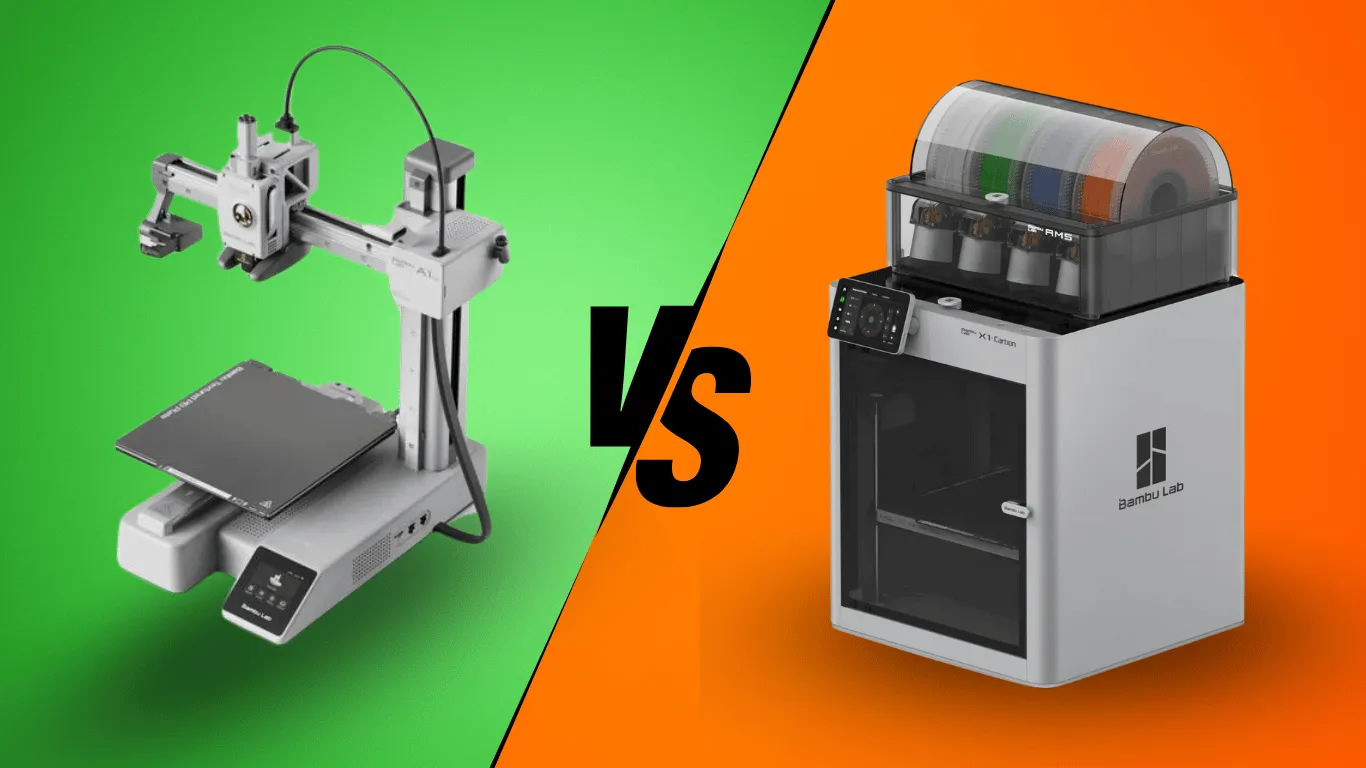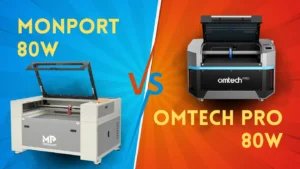Bambu Lab has made a big impact on the rapidly changing world of 3D printing with its innovative printers. Let’s dive into a head-to-head comparison of the Bambu Labs A1 Mini vs X1C, their entry-level and high-end models. After countless hours of tinkering, printing, and pushing these machines to their limits, I’ll help you choose the one that’s perfect for you.
The Setup Experience: From Box to First Print
Let’s kick things off with the unboxing and setup process, because let’s face it – nobody likes a complicated start.
Bambu Labs A1 mini:
Upon opening the Bambu Labs A1 Mini’s box, you’ll find a QR code linking to a video setup guide. Nice touch, Bambu Lab! The assembly process is a breeze, taking me just about 7 minutes for the printer itself and another 10-15 for the AMS Lite. The quick start manual is clear and concise, making the whole process feel like assembling LEGO for grown-ups.
Bambu Labs X1C:
The X1 Carbon is a more intricate device, so it takes a little longer to assemble. But Bambu Lab has made the process as simple as possible. The setup was quick and easy, taking only 20 minutes. However, the enclosed design requires a bit more attention during assembly. The manual is very helpful, but I found myself needing to double-check a few steps due to the printer’s advanced features.
Winner- Bambu Labs A1 mini
For sheer simplicity and speed of setup, the Bambu Labs A1 Mini takes the cake. It’s clear Bambu Lab designed this with beginners in mind, and it shows.
Pros ✅
Bambu Lab A1 Mini
+ Affordable entry point
+ Quick, easy setup
+ Active noise cancellation
Bambu Lab X1 Carbon
+ Large build volume
+ Wide material compatibility
+ Advanced features (Lidar, AI)
Cons 📛
Bambu Lab A1 Mini
– Smaller build volume
– Limited material compatibility
– Basic user interface
Bambu Lab X1 Carbon
– Higher price point
– More complex setup
– Larger footprint
Design and Build Quality: Beauty Meets Brawn
Bambu Labs A1 mini:
The A1 Mini sports a cantilevered bedslinger design, which is a departure from Bambu Lab’s typical CoreXY enclosed setups. It’s compact, yet solidly built. The linear rails give it a premium feel, and at 14.13 kg, it’s got some heft to it. The 180x180x180mm build volume is modest but should suffice for most hobbyist needs.
Bambu Labs X1C:
The X1 Carbon is a sight to behold. Its fully enclosed CoreXY design screams high-end, and the carbon fiber gantry isn’t just for show – it contributes to the printer’s impressive speed capabilities. With a larger 256x256x256mm build volume and weighing in at a substantial 22.3 kg (with AMS), it’s clear this is a more serious piece of kit.


Winner: Bambu Labs X1 Carbon
While both printers are well-built, the X1C’s premium materials and enclosed design give it the edge in this category.
Print Quality and Speed: The Rubber Meets the Road
Bambu Labs A1 mini:
Don’t judge it by its size. The A1 Mini is a surprisingly nimble printer. It can move at speeds up to 500mm/s, and in my tests, I was consistently impressed with its print quality. A 3D Benchy came out looking crisp in about 17 minutes, with minimal layer lines and excellent overhangs. The input shaping technology really shines here, minimizing ghosting even at high speeds.
Bambu Labs X1C:
The X1 Carbon is where things get wild. With the same 500mm/s top speed but a higher acceleration of 20,000 mm/s² (compared to the A1 Mini’s 10,000 mm/s²), this thing flies. I printed the same Benchy model in just under 15 minutes, and the quality was, if anything, slightly better than the A1 Mini’s. The enclosed design helps maintain consistent temperatures, which is particularly noticeable on larger prints.

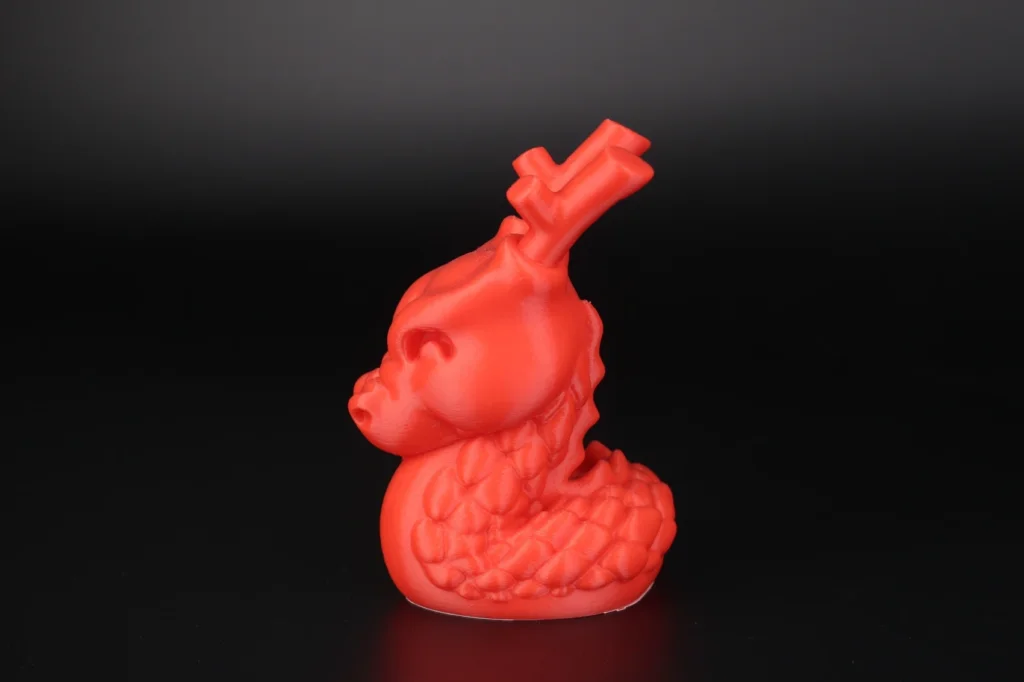
Winner: X1 Carbon
While both printers produce excellent results, the Bambu Labs X1C’s higher acceleration and enclosed design give it a slight edge in both speed and quality, especially on larger prints.
Multi-Material Printing: Colorful Creations
Bambu Labs A1 mini:
The A1 Mini comes with the option to add the AMS Lite, a streamlined version of Bambu Lab’s multi-material system. It handles up to four colors/materials and, in my testing, performed admirably. Color changes were quicker than I expected, though there’s still some waste during purges. I printed a multi-color Taylor Swift wall mount (don’t judge), and the results were impressive, with clean color transitions.
Bambu Labs X1C:
The X1 Carbon is compatible with the full AMS system, which can handle up to four spools out of the box, but can be expanded to an impressive 16 colors/materials with additional units. The system is more robust than the AMS Lite, with better filament management and drying capabilities. I recreated the same Taylor Swift print on the Bambu Labs X1C, and while the color quality was similar, the process felt more refined.

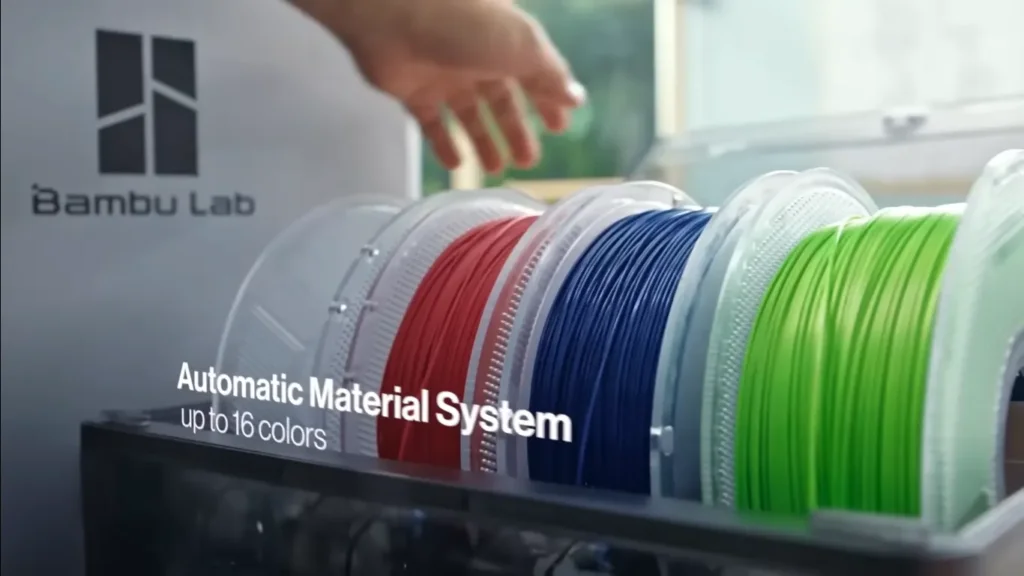
Winner: Tie
For most users, the A1 Mini’s AMS Lite will be more than sufficient. However, for those needing extensive multi-material capabilities, the Bambu Labs X1C’s expandable system is hard to beat. It really depends on your specific needs.
User Interface and Software: The Brains of the Operation
Bambu Labs A1 mini:
The A1 Mini features a small 2.4-inch IPS touchscreen. It’s functional but can feel a bit cramped. I found myself relying more on the Bambu Handy app and Bambu Studio software for most operations. The printer’s Wi-Fi connectivity is solid, and the built-in camera, while basic, gets the job done for remote monitoring.
Bambu Labs X1C:
The X1 Carbon boasts a larger, more responsive touchscreen that makes on-printer operations a breeze. The built-in camera is of higher quality, providing clearer monitoring and better time-lapse videos. Like the A1 Mini, it integrates seamlessly with Bambu’s software ecosystem.
Both printers use Bambu Studio, a modified version of PrusaSlicer, which I found to be intuitive and powerful. The cloud integration is a nice touch, allowing for easy print management and monitoring from anywhere.
Winner: X1 Carbon
The larger, more responsive screen and better camera give the X1C the edge here, though both printers benefit from Bambu’s excellent software ecosystem.
Filament Management:
Bambu Labs A1 mini:
The A1 Mini introduces the AMS Lite, a streamlined version of Bambu Lab’s multi-material system. It handles up to four colors/materials with motorized spools feeding directly to the extruder, eliminating long retractions. This system is more efficient than the standard AMS, allowing for quicker color changes. However, multi-material printing still results in significant filament waste due to purging.
Bambu Labs X1C:
The X1 Carbon offers the full AMS (Automatic Material System), supporting up to four spools out of the box, expandable to 16 colors/materials. The top-loading design makes filament swapping a breeze, and it includes features to keep filament dry and in optimal condition. The system is more robust than the AMS Lite, with better filament management capabilities.
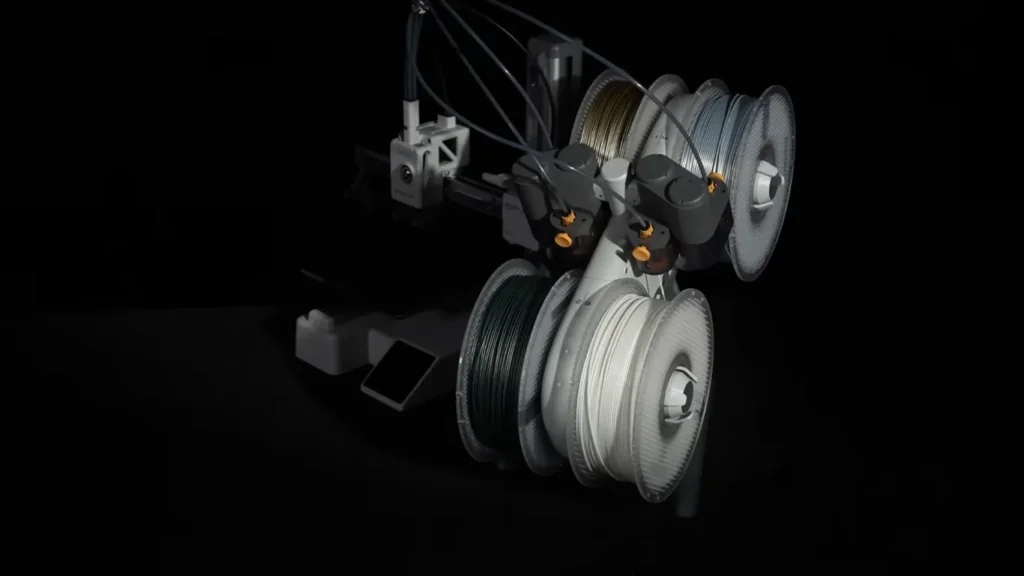
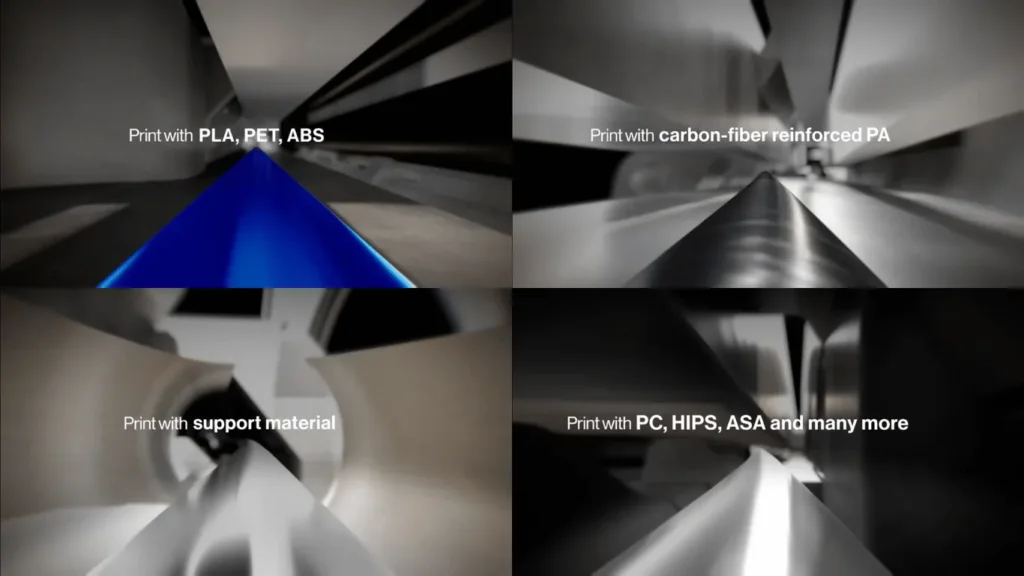
Winner: X1 Carbon
While the A1 Mini’s AMS Lite is impressive for its price point, the Bambu Labs X1C’s full AMS system offers greater versatility and expandability, making it the clear choice for users needing extensive multi-material capabilities.
Noise Levels:
Bambu Labs A1 mini:
The Bambu Labs A1 mini features innovative active motor noise canceling technology, a first in consumer 3D printers. This system measures motor imperfections and cancels out noise in real-time, allowing the printer to achieve noise levels as low as 48dB in silent mode. However, the part cooling fan remains the loudest component during operation, which can still be noticeable.
Bambu Labs X1C:
The X1 Carbon, while not specifically marketed for low noise, benefits from its enclosed design which naturally dampens operational sounds. Its core XY design and high-quality components contribute to smoother, quieter movements. Users generally report comfortable noise levels, especially compared to open-frame printers.

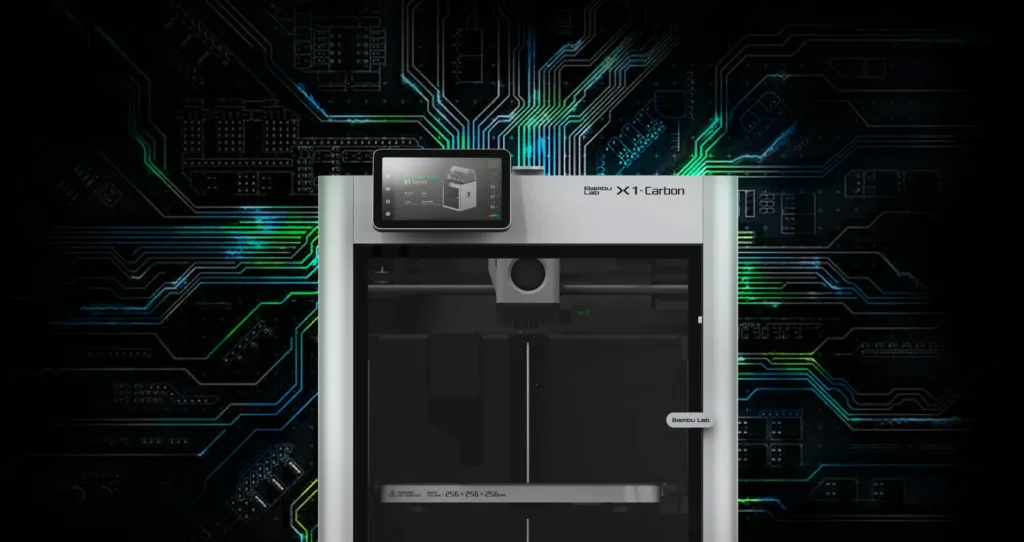
Winner: Bambu Labs A1 mini
Despite the Bambu Labs X1C’s enclosed design, the A1 Mini’s active noise cancellation technology gives it the edge in this category. It’s pushing the boundaries of what’s possible in terms of quiet operation in the consumer 3D printing space.
Special Features: The Cherry on Top
Bambu Labs A1 mini:
- Active motor noise canceling (gets down to about 48dB in silent mode)
- Quick-swap nozzle design
- Auto bed leveling with nozzle probing
- Flow rate compensation
Bambu Labs X1C:
- Lidar-based auto bed leveling
- AI-powered first layer inspection
- Spaghetti detection
- Higher temperature capabilities (up to 300°C)
- Active chamber temperature control
Winner: X1 Carbon
The A1 Mini has some Smart features, but the Bambu Labs X1C’s advanced technology, especially its Lidar and AI, sets it apart.
Material Compatibility: Pushing the Boundaries
Bambu Labs A1 mini:
The A1 Mini handles PLA, PETG, and TPU like a champ. I ran a series of tests with different materials, and it performed admirably across the board. However, it’s not ideal for more exotic materials like carbon fiber-infused filaments or ABS due to the lack of an enclosed chamber and a max nozzle temp of 300°C.
Bambu Labs X1C:
This is where the X1 Carbon really shines. With its enclosed design, hardened steel nozzle, and higher temperature capabilities, it can handle everything the A1 Mini can, plus ABS, ASA, PC, and even carbon fiber-infused filaments. I printed some CF-Nylon parts for a drone project, and the results were outstanding.


Winner: X1 Carbon
The Bambu Labs X1C’s broader material compatibility makes it the clear winner for users who want to experiment with a wide range of filaments.
Maintenance and Reliability: The Long Haul
Bambu Labs A1 mini:
Over my six weeks of testing, the Bambu Labs A1 mini proved to be a reliable little workhorse. I encountered one clogged nozzle, likely due to some questionable filament I was using, but the quick-swap nozzle design made it a breeze to fix. The belt tension monitoring is a nice touch, helping to prevent issues before they arise.
Bambu Labs X1C:
The X1 Carbon, despite its more complex design, has been running like a dream for the past six months. The enclosed design helps keep dust out, and the higher-quality components seem to contribute to its longevity. I’ve had no significant issues, though I did experience one filament jam early on, which was easily resolved.
Winner: Tie
Both printers have demonstrated consistent reliability. The A1 Mini’s streamlined design may be easier for new users to maintain, while the Bambu Labs X1C’s sturdy construction ensures it will last for a long time.
Price and Value: The Bottom Line
Bambu Labs A1 mini:
For just $299, the A1 Mini offers exceptional value as a starting point in 3D printing. If you need more features, the AMS Lite upgrade for $459 provides a powerful and affordable option. Whether you’re new to 3D printing or seeking a reliable secondary machine, the Bambu Labs A1 mini is a fantastic choice.
Bambu Labs X1C:
The X1 Carbon is a considerable expense, priced at around $1,200 for the basic version and $1,450 with the AMS. Nevertheless, for those requiring its sophisticated features, the cost can be warranted.
Winner: Bambu Labs A1 mini
For sheer value proposition, the A1 Mini is hard to beat. It offers many of Bambu Lab’s advanced features at a fraction of the cost of the X1C.
Bambu Labs A1 Mini vs X1C Specification Chart:
| Feature | Bambu Lab A1 Mini | Bambu Lab X1 Carbon |
|---|---|---|
| Build Volume | 180x180x180mm | 256x256x256mm |
| Max Print Speed | 500mm/s | 500mm/s |
| Max Acceleration | 10,000 mm/s² | 20,000 mm/s² |
| Filament System | AMS Lite (up to 4 colors) | AMS (up to 16 colors) |
| Enclosure | Open | Fully enclosed |
| Max Nozzle Temp | 300°C | 300°C |
| Bed Leveling | Auto (nozzle probing) | Auto (Lidar) |
| Noise Reduction | Active motor noise canceling | Passive (enclosure) |
| Price (base/with AMS) | $299 / $459 | $1,200 / $1,450 |
The Verdict
After weeks of testing, printing everything from Benchys to complex multi-color models, it’s clear that both the Bambu Lab A1 Mini and X1 Carbon are exceptional printers in their respective categories.
The Bambu Labs A1 mini is a game-changer for budget-conscious users. It offers many of Bambu Lab’s advanced features at a lower price. This makes it perfect for use by first time users as well a second printer fallback. An easy-to-install printer with a small footprint and solid output.
The X1 Carbon is an efficient printer. It is faster, more reduced and attuned to hobbyists as well professionals. The Bambu Labs X1C is great if you have to print in different materials, larger sizes and want the best quality or speed.
So, which one reigns supreme? Well, it depends on your needs and budget:
You are a beginner, hobbyist or in the element of budget conscious then Bambu Labs A1 mini is best suitable for you. It offers incredible value and performance.
For enthusiasts, professionals, or those needing maximum versatility: The X1 Carbon takes the crown. Its advanced features, broader material compatibility, and higher performance justify its premium price tag.
In the end, Bambu Lab has created two excellent printers that cater to different segments of the market. Whether you go with the plucky Bambu Labs A1 mini or the powerhouse X1 Carbon, you’re getting a printer that represents the cutting edge of consumer 3D printing technology. Happy printing!
FAQs:
Can I use third-party filaments with these printers?
Both the A1 Mini and X1C are designed to work best with Bambu Lab filaments, but they can handle third-party options. Just keep in mind that using non-Bambu filaments might affect print quality and could potentially void your warranty. If you’re feeling adventurous, start with PLA from reputable brands and work your way up from there.
How does the print speed compare between the Bambu Labs A1 mini and X1C?
The Bambu Labs X1C is the speed demon here. While both printers can hit travel speeds of 500mm/s, the X1C’s higher acceleration (20,000 mm/s² vs the A1 Mini’s 10,000 mm/s²) means it can reach top speeds more quickly. In real-world terms, a print that takes 7 hours on the X1C might take about 8 hours on the A1 Mini. Still impressive for an entry-level printer!
Are these printers beginner-friendly?
Absolutely! Both the A1 Mini and X1C are designed with user-friendliness in mind. They feature auto-calibration, easy setup processes, and intuitive interfaces. Although the A1 Mini is meant to be affordable and accessible for beginners, it would definitely not operate that way just because of its so-called entry level price. The Bambu Labs X1C may be better, but there is no plug-in.
Can these printers handle high-temperature materials like ABS or Nylon?
The Bambu Labs X1C is your go-to for high-temp materials. With its enclosed design and ability to handle nozzle temperatures up to 300°C, it can tackle ABS, Nylon, and even some carbon fiber-infused filaments. The Bambu Labs A1 mini, while impressive, isn’t designed for these more demanding materials. Stick to PLA, PETG, and TPU with the little guy.
How do the build volumes compare?
Size matters, folks! The Bambu Labs A1 mini is a compact 3D printer and an assembly volume with dimensions of 180x180x180 mm, perfect for small or space-consuming projects. One higher-end model, the Bambu Labs X1C, offers a build area of 256x256x256mm. If you’re planning on printing larger models or batch producing, the X1C gives you more room to play.
Nikko Jenkins is a technology journalist based in the US, covering tool reviews and comparisons across North America, Europe and Asia, particularly 3D Printers. His concise, insightful articles on the latest innovations help readers worldwide make informed tech decisions. Jenkins’ expertise and engaging style have made him a respected voice in the global technology landscape.
Feel free to reach out to me at nikkojenkins@360techinsights.com.

